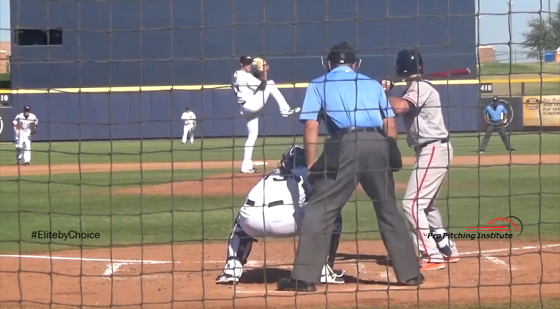The Truth about Pitching.
What you think you see isn’t what happens.
Human nature dictates, when you see something you
don't understand, you come up with a reason for what you see. When you see
a pitching motion, you find a reason for everything you see, but, most of the
time, the way you think about the pitching motion assumes things that don’t
happen.
All
too often, the facts contradict your slant on what you see happen. When you don’t accept a fact that can be proven true,
you effectively block yourself from achieving success on the mound.
Here’s the truth …the messages your actions send to your inner ear
determine your throwing arm path which sets the stage for where your next pitch
ends up and how your pitch moves as it comes toward your opponent.
How Your Inner Ear Impacts Your Pitching Movements?
The Way Your Body Works
Your inner ear includes a sensory system that continually
directs your subconscious mind how to take over and reposition your body parts
to keep your body in balance.
Your inner ear makes sure you keep your hips level, your
core upright and your weight centered within your “base of support”. When your
inner ear senses even the slightest imbalance, your inner ear sends your subconscious a
balance alert to take the required actions that’ll get your weight back
to center.
Even
pitching motion videos fail to tell the entire story.
Your inner ear processes information 500,000 times faster
than your conscious mind. No matter how you want your body to move, when your
inner ear senses an imbalance, your subconscious instantly overrides what you
want to do and decides how your body will move.
Unless you know what to look for, even when you analyze
a pitching motion video, you tend to perceive subconscious inner ear reactions
as a controllable action.
As soon as you confuse a subconscious reaction as a
controllable action, your inner ear will always change the way you want to
move.
Your Inner Ear Reacts to Your Pitch's “Base of Support”
A typical “base of
support”.
With both feet on the ground, your feet are your “base of
support”. Your inner ear uses your legs to center your weight within
your “base of support”.
Single-leg “base of
support”.
With only have one foot on the ground, your “base of support” transfers
from your feet to your knees. In this instance, to keep your weight centered
within your “base of support”, your inner ear instinctively and continually
directs your subconscious when and how to reposition your arms, legs and core.
Stable single-leg
balance.
As long as you maintain a distance between your knees and keep
your weight centered within your “base of support”, your inner ear keeps your
arms free to move any way you want. From
this balanced position, when you use an arm to twist your core, you
automatically activate your inner ear to do what it must do to get your body
back into alignment.
In pitching, when
you end your front leg lift with your inner ear sensing single-leg balance,
your glove arm remains free to twist your core which forces your inner ear to
use an involuntary throwing reflex (a throwing reaction) to bring your body
back to balance. The result becomes a “1-piece”
reaction where your body and throwing arm work together to produce an effortless,
limitless and sustainably excellent pitching experience.
Unstable single-leg
balance.
When you have only one foot on the ground and there no distance
between your knees, your back foot becomes your “base of support”. With all
your weight over your back foot, you won’t move toward your target unless you
make some action that’ll tilt your weight to one side of your back foot. As
soon as you move your weight outside your “base”, your inner ear is going to
use your arms to counterbalance your weight shift.
In pitching, when,
as you lift your front leg, your inner ear places all your weight over your
back foot, to move toward your target, you’re forced to tilt your weight toward
your target. Your tilt causes your inner ear to use your throwing arm to offset
your forward weight shift. Only when your front foot gets on the ground and
your inner ear senses your weight is centered between your feet does your inner
ear free your throwing arm to complete your delivery. The result becomes a “2-part”
delivery where, because your inner ear forces your throwing arm work independently without any meaningful
contribution from your body, you go to the mound never really knowing what your next will do nor where it'll end up.
What does a “sustainably excellent pitching motion” look like?
You end your front leg lift with your weight centered within
your “base of support”. Your balanced position lets you use your free glove
side arm to twist your core. Your twist begins a planned series of inner ear
adjustments ending with an involuntary throwing reflex (a throwing reaction).
As an inner ear prompted reflex, your throwing arm always shows your opponent a
fastball arm speed, your consistently tiny release window is built to deliver
every pitch directly into your target and, in the end, you challenge every
opponent to solid contact with every pitch.
What does an “ordinary” pitching motion look like?
Because you end your front leg lift with your weight over
your back foot, no matter how hard you want to make your throwing arm path more
productive than you last, your inner ear will always disrupt the throwing arm
path you want. Your inner ear involvement means you never know where your ball
is going to end up and you never achieve the sustainably excellent results you
know you have in you.
Either you manage your inner ear or your inner ear is going to manage you. It's your choice!
Skip Fast
Chief Learning Officer/Executive Director
Professional Pitching Institute
Copyright © 2018















